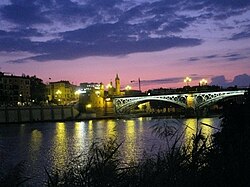User:Kellysnod
Puente de Triana | |
|---|---|
 | |
| Characteristics | |
| Design | Three Arches |
| Material | Iron and Stone |
| No. of spans | Guadalquivir River |
| History | |
| Engineering design by | Gustavo Steinacher and Fernando Bernadet |
The Puente de Triana, or the "Bridge of Triana," is a bridge located in Seville (Andalusia, Spain). It joins the City Center to the neighborhood of Triana by crossing the Guadalquivir River that was originally known as the Puente de Barcas, or the "Bridge of Boats," in the 19th century. It is the oldest preserved iron bridge in Spain.
History
The Puente de Triana began as the Puente de Barcos in 1171 and lasted until 1852. This was an iconic symbol created by Abu Yaqub Yusuf, the Caliph of this time period of the Almohad dynasty, which lasted from 1147-1248 [1]. The Puente de Barcos consisted of 13 boats chained together from bank to bank and served as a makeshift bridge. Until 1852, this was the only connection between two banks of the Guadalquivir from Córdoba to Sanlúcar de Barrameda.
The location of the Puente de Barcos coincides with the location of the Puente de Triana, and was only shifted east to the area in front of the Plaza de Toros when the construction of the Puente de Triana began in 1845 [2].

Current Form
In April of 1945, a design modeled after the Pont du Carrousel in Paris, France (which no longer exists) was approved. French engineers by the names of Gustavo Steinacher and Fernando Bernadet began construction on pillars of stone and iron. Along the Triana-side bank of the river, a large ramp was connected to link the bridge to San Jorge street.
The Puente de Triana, being the only connection between the two banks of the Guadalquivir, was christened Puente de Isabel II on February 21, 1852. The Puente de Triana finally linked the Gypsy neighborhood of Triana with the City Center of Seville[3].
On April 13, 1976, the Puente de Triana was declared a National Historic Monument. The following year, 1977, it was restored by an engineer from the nearby town of Huelva, Juan Batanero and was re-inaugurated on June 13, 1977.
The Chapel

On top of the Triana side of the bridge, the Chapel of Carmen resides. Constructed by a regional architect, Anibal Gonzalez. The bridge and chapel are commonly thought of as one of the iconic sites of Seville and rather than existing as two separate monuments, coincide as one[4].
Name of the Bridge
The Puente de Triana is also known as the Puente de Isabel II, seeing as it was constructed under the reign of Isabel II. The name Puente de Triana originates from the neighborhood Triana, to which the bridge connects the city center.
References
- ^ "History of Seville's Bridges" http://www.sevillaweb.info/historia5_sevilla.html
- ^ "The Construction of Puente de Isabel II" http://gilbert.aq.upm.es/sedhc/biblioteca_digital/Congresos/CNHC1/CNHC1_037.pdf
- ^ http://www.sevillaen360.es
- ^ http://www.privilegespain.es
